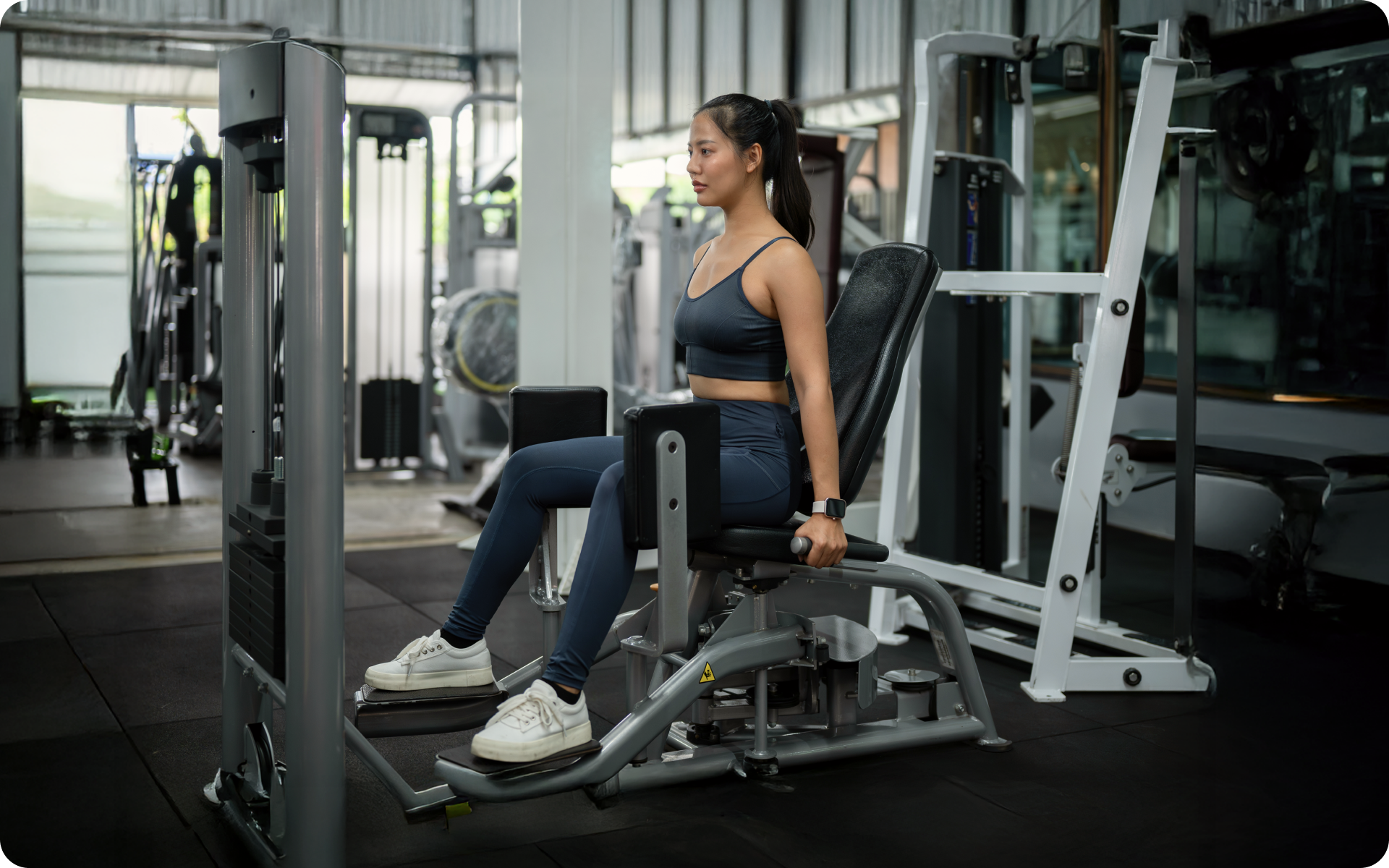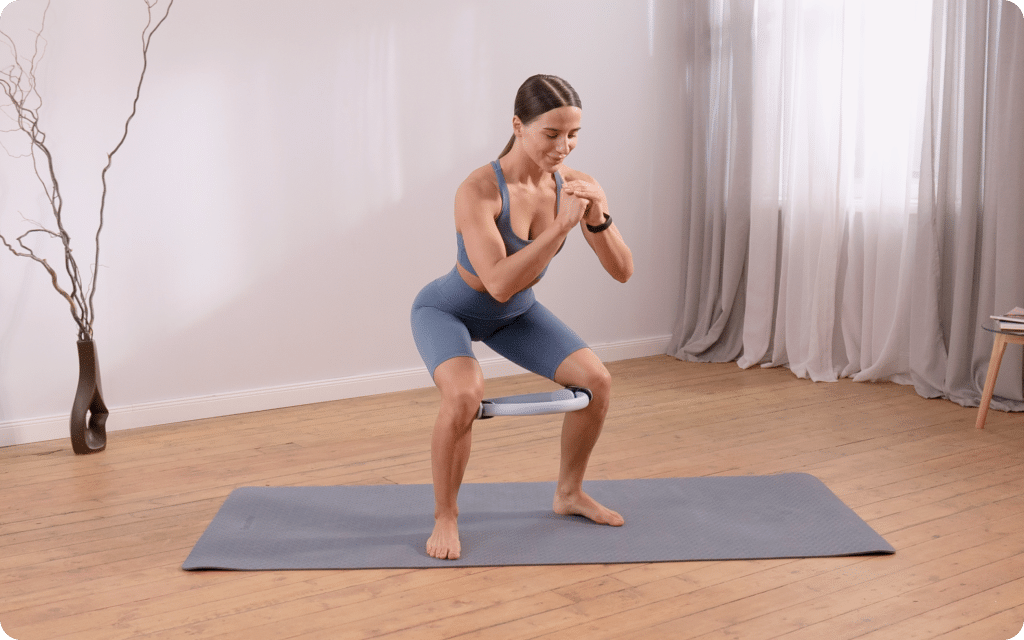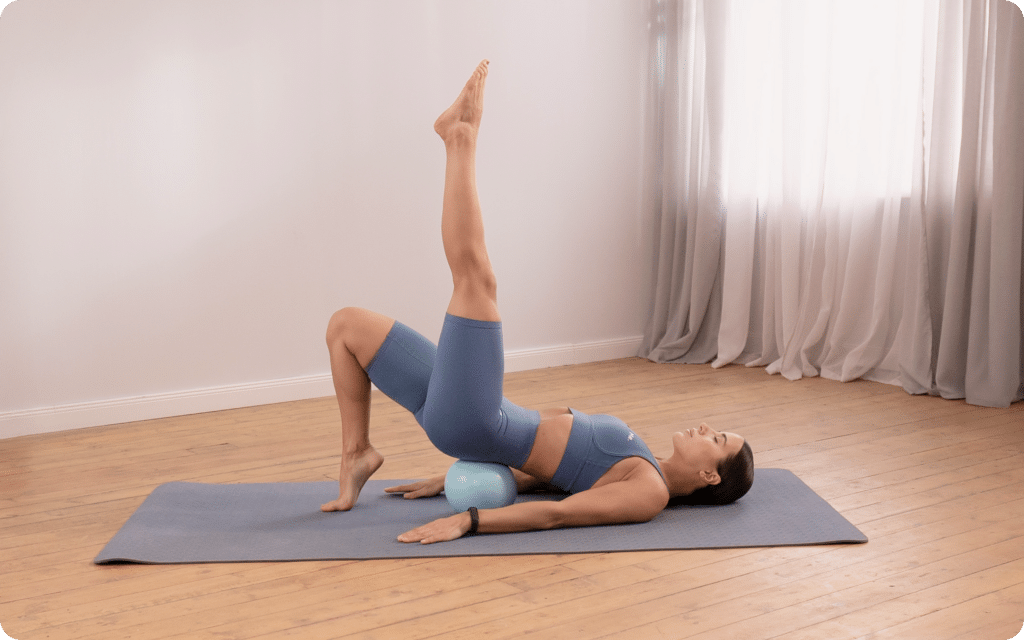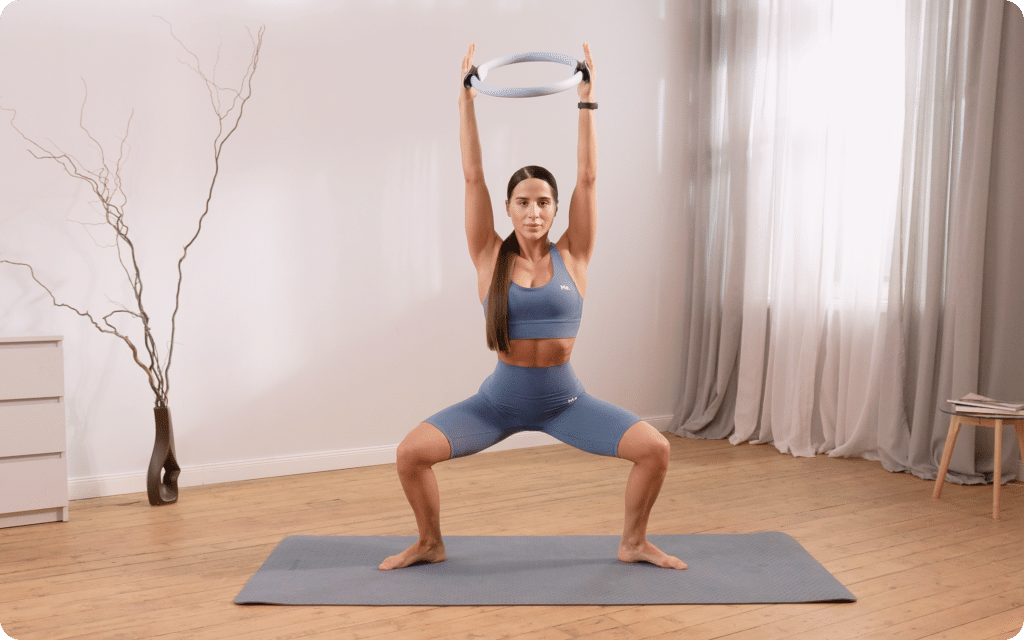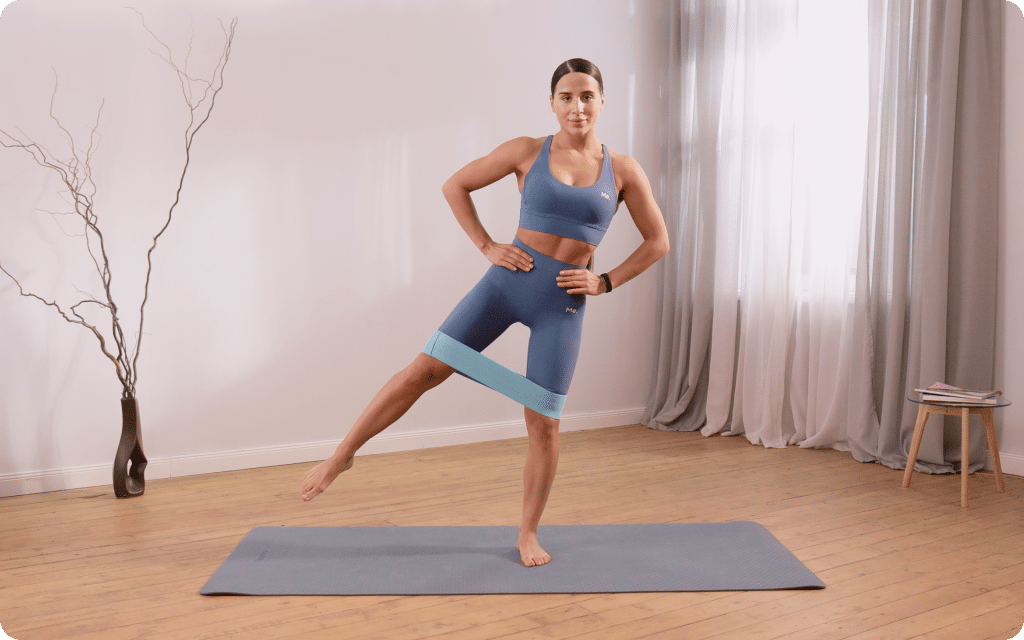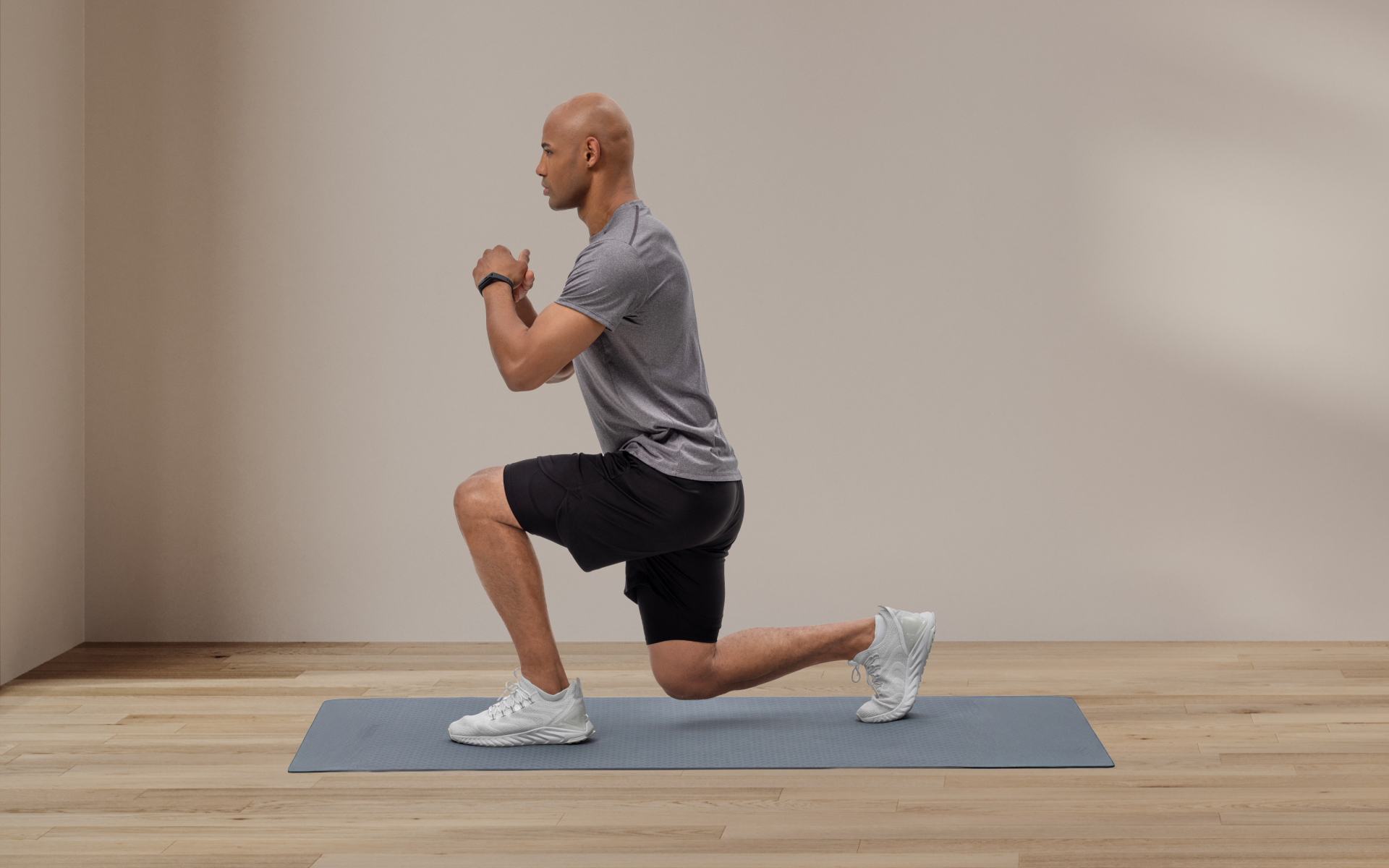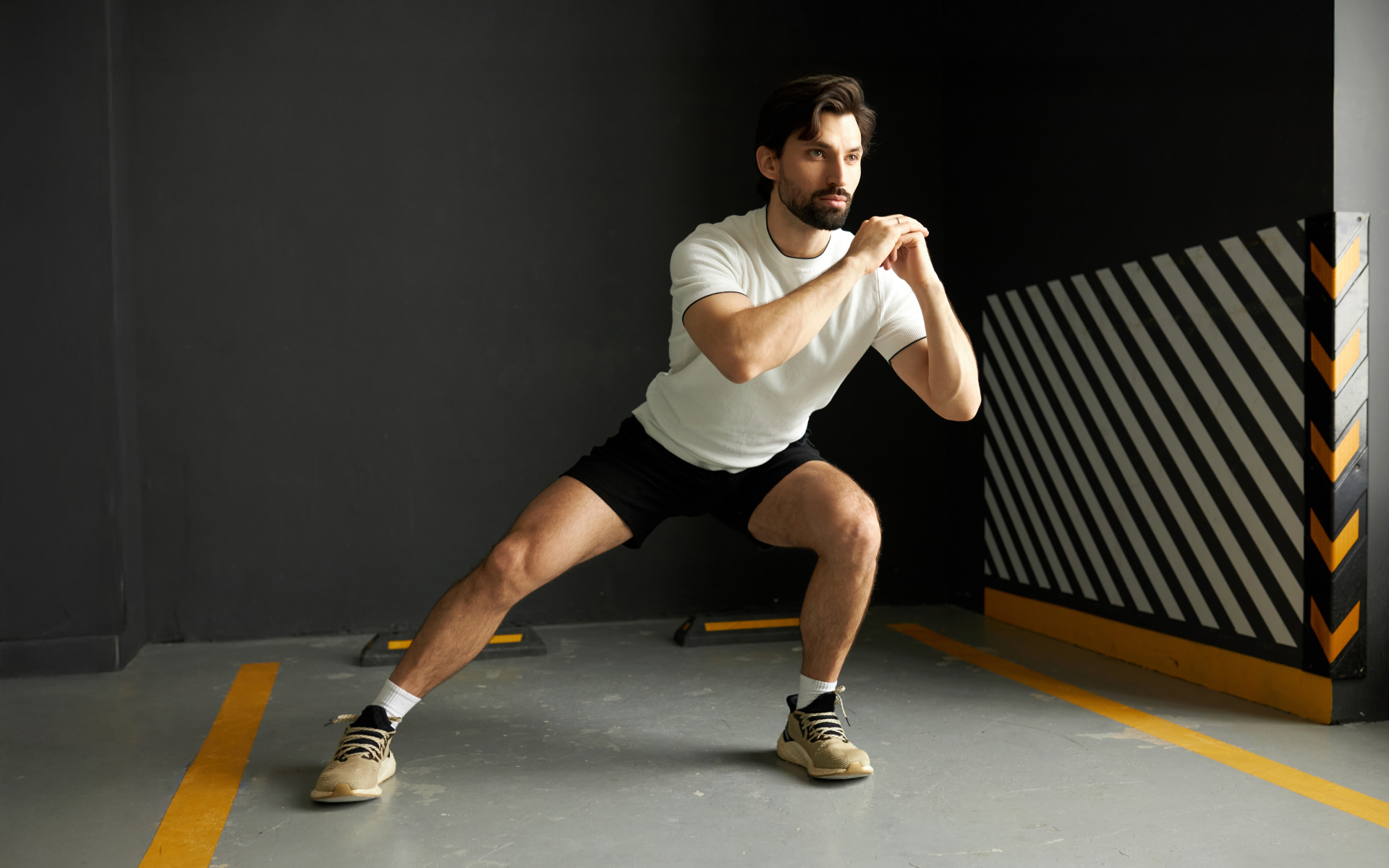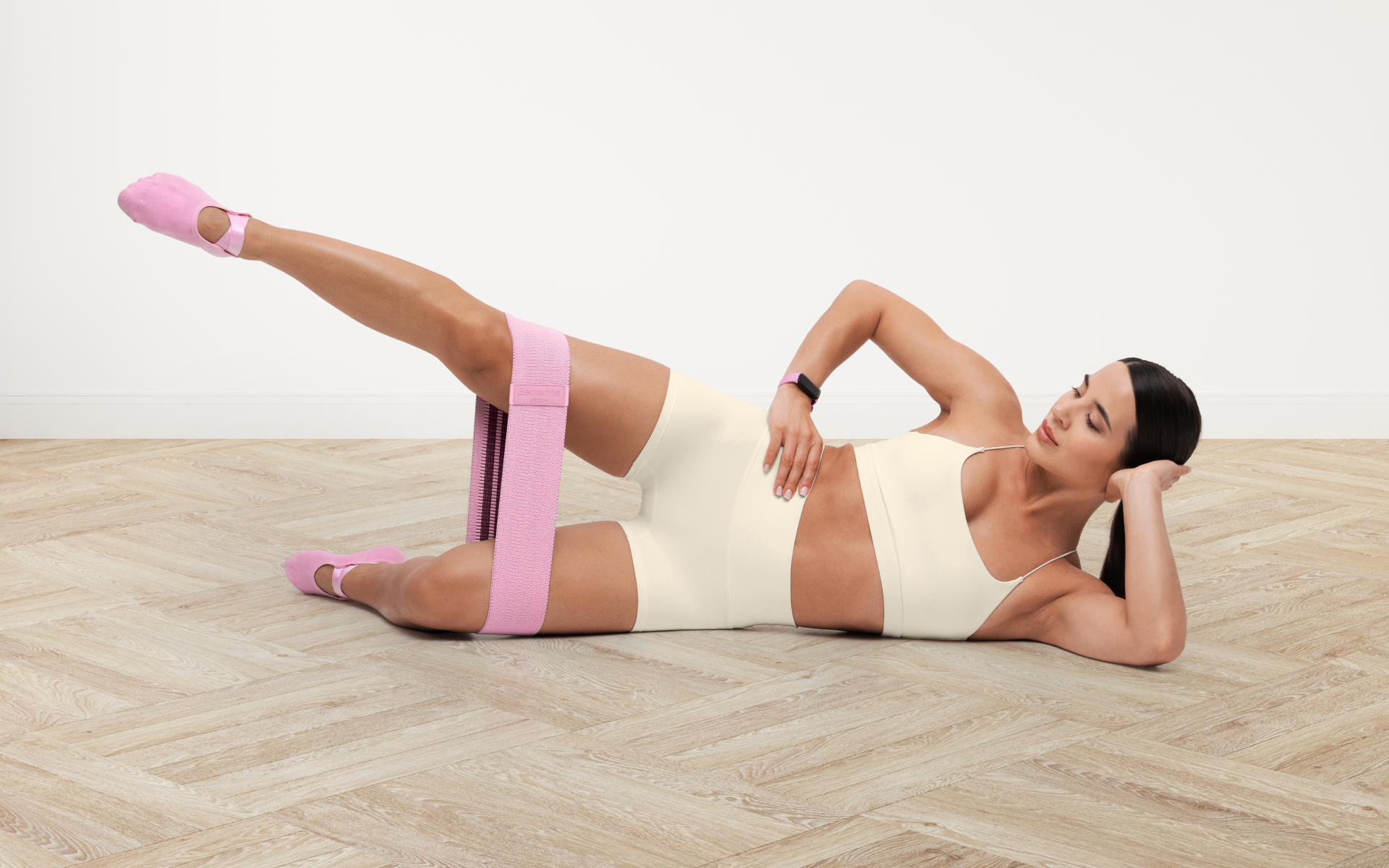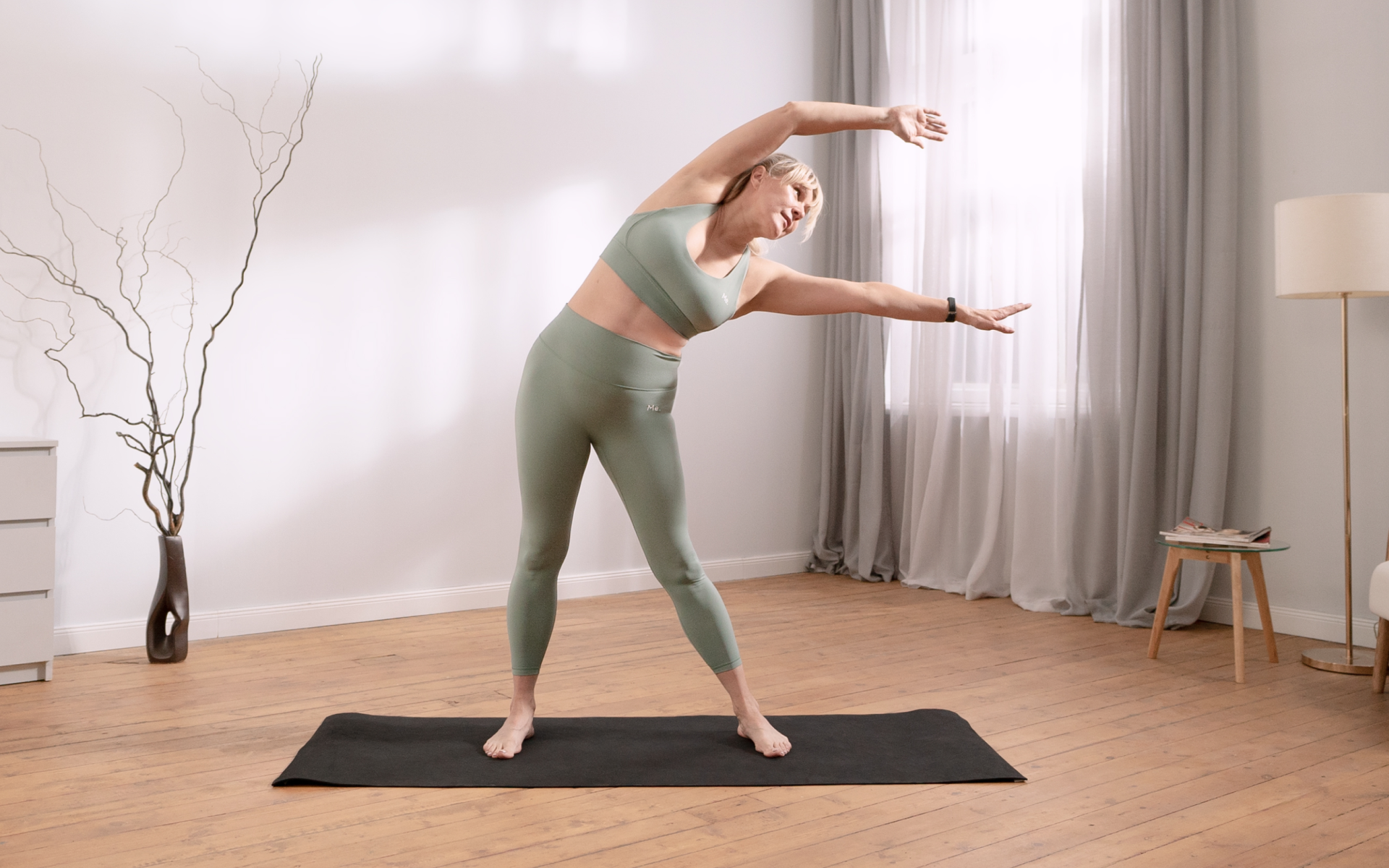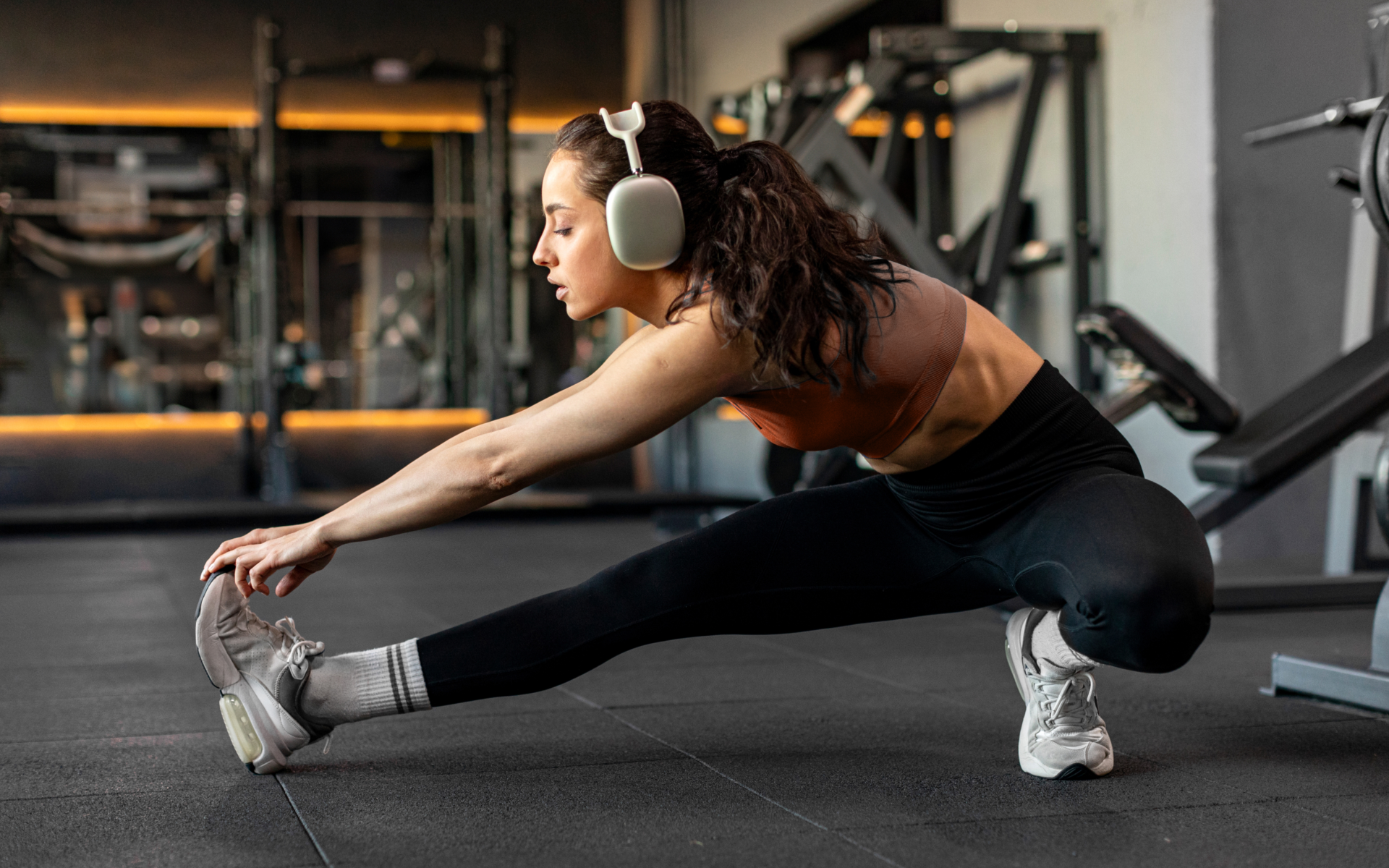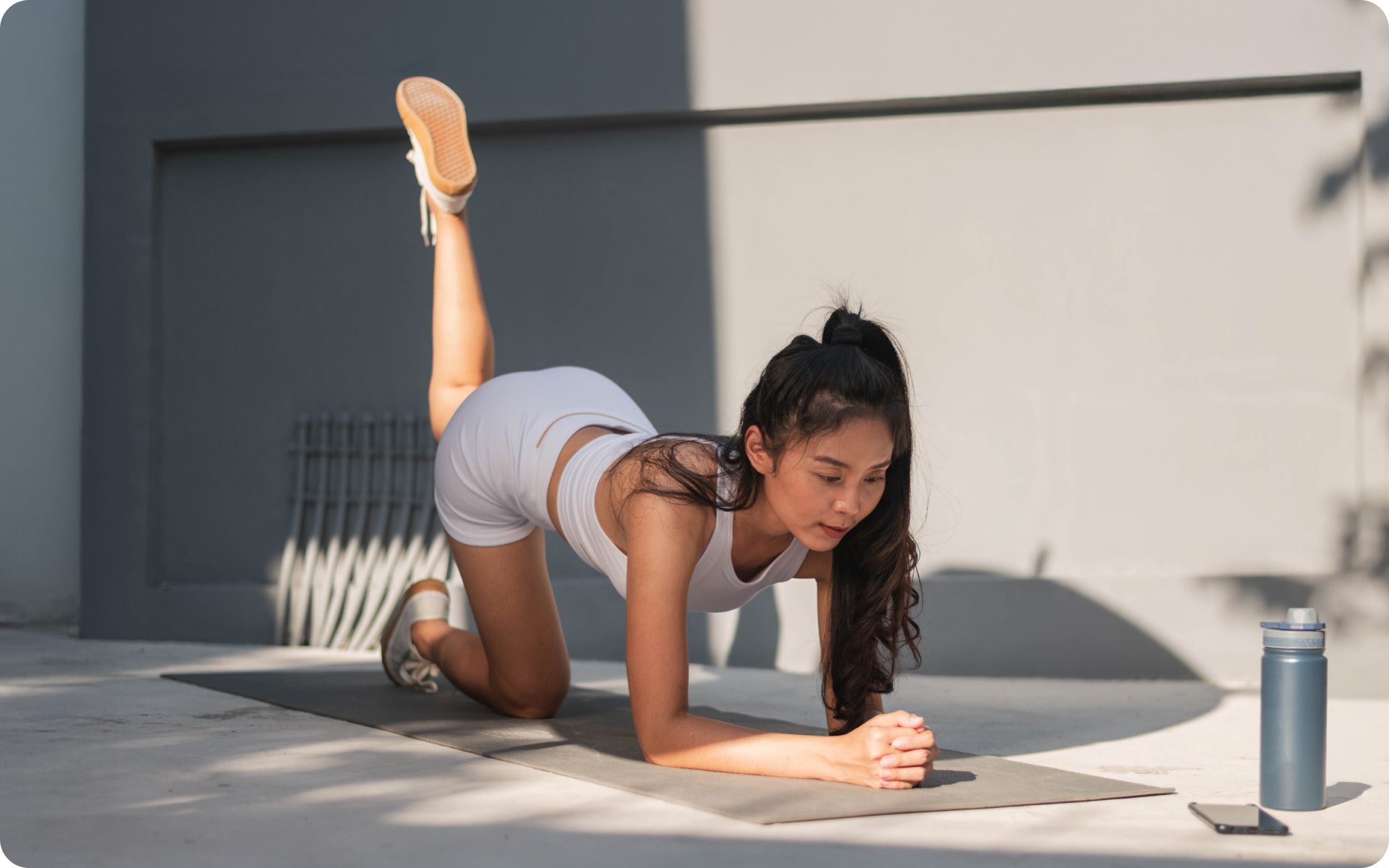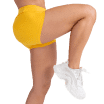The lower body is home to some of the largest and most powerful muscles in your body. These include the quadriceps, hamstrings, glutes, and calves. Targeting them effectively enhances performance and plays a key role in preventing injury and developing a balanced physique. Whether your goal is to build muscle, tone up, or improve functional strength, lower-body training deserves a front-and-center spot in your routine.
This guide will walk you through a simple lower-body gym workout. In it are six essential exercises that will work every major muscle group in this area.
How Do You Train Your Lower Body at the Gym?
Training your lower body effectively requires a mix of proper form, muscle activation, and progressive overload. This well-structured approach ensures you target all major muscle groups while minimizing the risk of injury.
Here’s how to do it:
Prioritize Proper Form
Proper form is non-negotiable. It’s the foundation of safe and efficient training (1). Every exercise has a specific range of motion and joint alignment that optimizes muscle engagement while protecting your body.
For example, when squatting, you need to be sure to:
- Keep your chest up
- Track your knees over your toes
- Push your hips back and down as if sitting on a chair.
This alignment ensures the quadriceps, hamstrings, and glutes share the workload without placing any undue stress on your knees or lower back.
Practicing proper form reduces the risk of compensations (1). Compensations occur when other muscles take over to “help” during an exercise, which often leads to imbalances or joint strain.
You should also always start with a manageable weight to master the movement basics.
Engage the Right Muscles
Increasing muscle activation is key for efficiency (2). Before heavy lifts, perform a brief warm-up to stimulate the muscles you’re about to train (3).
For example, glute bridges or bodyweight lunges can help “wake up” your glutes and improve their contribution during squats or deadlifts. When your target muscles are active, they’re able to work harder and produce more force during the exercise, which leads to better results.
Focus on feeling the muscles you’re targeting. This is known as the mind-muscle connection. It’s a way of tuning in to ensure you’re moving with purpose, activating the intended muscle groups rather than relying on momentum or other body parts (4). Our previous post goes into great detail about the glute activation exercises.
Apply Progressive Overload
Progressive overload is the gradual increase of stress placed on the muscles over time. This is essential for muscle growth (hypertrophy) and strength development (5).
You can apply overload through several mechanisms such as:
- Increasing the weight
- Adding more repetitions
- Adjusting the exercise difficulty
For example, if you’ve mastered the bodyweight squat, you can progress to goblet squats or barbell squats.
Be patient with progression. Adding too much weight too soon increases injury risk. Instead, prioritize small, consistent increments that allow your muscles and connective tissues to adapt.
When it comes to weight loss, progress is made by inches, not miles, so it’s much harder to track and a lot easier to give up. The BetterMe: Health Coaching app is your personal trainer, nutritionist, and support system all in one. Start using our app to stay on track and hold yourself accountable!
Target All Major Muscle Groups
The lower body is comprised of key muscle groups that work together to support everyday movements and athletic performance (6). Each group has a specific role and is activated by different types of movement patterns.
- Quadriceps (Front Thighs)
The quadriceps extend the knee and stabilize the joint. Movements such as squats, lunges, and step-ups recruit these muscles. These are foundational exercises for building strength and functional power. - Hamstrings (Back Thighs)
The hamstrings flex the knee and assist with hip extension. Romanian deadlifts, glute-ham raises, and Nordic curls target these muscles. They’re essential for movements such as running, jumping, and lifting. - Glutes (Buttocks)
The gluteal muscles are responsible for hip extension, abduction, and rotation. They are heavily activated during squats, hip thrusts, and Bulgarian split squats. Strong glutes improve posture and hip stability. - Calves (Lower Leg)
The calves, including the gastrocnemius and soleus, control ankle plantarflexion. Exercises such as calf raises and sled pushes target these muscles. They enhance ankle stability and power during walking, running, or jumping. - Adductors (Inner Thighs)
These muscles pull the legs toward the midline and stabilize the hips. Side lunges and Copenhagen planks are great for engaging the adductors, which are often overlooked yet integral for overall lower-body strength. - Abductors (Outer Hips and Thighs)
The abductors, including the gluteus medius and minimus, are responsible for moving the leg away from the midline (hip abduction) and stabilizing the pelvis. These muscles are activated during lateral band walks, clamshell exercises, and single-leg movements such as step-ups. Strong abductors reduce the risk of hip and knee imbalances, particularly during dynamic activities.
Each of these muscle groups ties in several essential fundamental movement patterns, which include:
- Squatting
- Lunging
- Hip hinging
- Stepping
- Lateral moves
Integrating these patterns into your workouts will ensure you activate every major muscle group, promoting balanced development and functional strength.
Set Aside Time for Rest and Recovery
Lastly, allow your lower body adequate time to recover between sessions. Researchers believe that muscle tension is the primary driver of muscle growth as well as metabolic damage (7, 8). A third stimulus is muscle damage, aka microtears in muscle fibers, which repair and grow stronger during rest. Training the same muscle groups too frequently without proper recovery can hinder progress.
Generally, 48 to 72 hours is recommended between intense lower-body sessions (9). To learn more about lower body calisthenics, check out our in-depth article on the topic.
Read more: 20-Minute Cardio Workout: Quick, Effective, and Beginner-Friendly
What Exercises Are Good for A Lower Body Gym Workout?
These six exercises provide a comprehensive workout to strengthen all major lower body muscle groups through varied movement patterns.
1. Heel Elevated Barbell Squat
The heel elevated barbell squat targets the quadriceps, glutes, and hamstrings while also engaging your core for stability. Elevating the heels increases knee flexion, which places more emphasis on the quadriceps.
Steps to execute:
- Place a pair of weight plates or a wedge under your heels.
- Position a barbell across your upper back, gripping it firmly with both hands.
- Stand with your feet shoulder-width apart and your heels elevated.
- Brace your core, keep your chest up, and slowly lower your body by bending your knees and hips.
- Descend until your thighs are at least parallel to the floor.
- Push through your heels and return to a standing position.
2. Romanian Deadlift (RDL)
The Romanian deadlift primarily targets the hamstrings and glutes, with secondary activation of the lower back and core. It focuses on the hip hinge pattern.
Steps to execute:
- Stand with feet shoulder-width apart, holding a barbell in front of your thighs with an overhand grip.
- Keep a slight bend in your knees and hinge at your hips, lowering the barbell toward the ground.
- Maintain a straight back and allow the barbell to travel close to your legs.
- Stop when you feel a stretch in your hamstrings or the bar reaches mid-shin level.
- Engage your glutes and drive your hips forward to return to the starting position.
3. Hip Thrust
The hip thrust is an excellent exercise for targeting the gluteus maximus, with some engagement of the hamstrings and lower back.
Steps to execute:
- Sit on the floor with your upper back against a bench and a loaded barbell resting across your hips.
- Bend your knees and place your feet flat on the ground, hip-width apart.
- Brace your core and thrust your hips upward by squeezing your glutes.
- Stop when your hips are fully extended and your body forms a straight line from your shoulders to your knees.
- Lower your hips back to the ground in a controlled motion and repeat.
4. Nordic Curls
Nordic curls are a challenging bodyweight exercise that isolates the hamstrings, focusing on eccentric strength.
Steps to execute:
- Kneel on a padded surface and anchor your feet under a secured bar or weighted object.
- Cross your arms over your chest and keep your torso straight.
- Slowly lower your upper body forward by extending your knees, keeping your hips in line with your torso.
- Go as low as you can while controlling the movement.
- Use your hamstrings to pull yourself back to the starting position or use your hands for assistance.
5. Seated Hip Abduction/Adduction Machine
This machine isolates the adductors (inner thighs) during hip adduction and the abductors (outer hips) during hip abduction.
Steps to execute for hip abduction:
- Sit on the machine and position your legs between the outer thigh pads.
- Adjust the range of motion to a comfortable position.
- Push your legs outward against the pads, squeezing your glutes.
- Slowly return to the starting position and repeat.
Steps to execute for hip adduction:
- Sit on the machine and position your legs outside the pads.
- Squeeze your legs together, engaging the adductors.
- Slowly release and return to the starting position.
6. Calf Raises
Calf raises target the gastrocnemius and soleus muscles in the lower leg, improving ankle strength and stability.
Steps to execute:
- Stand on a raised platform or step with your heels hanging off the edge.
- Hold onto a support for balance if needed.
- Push through the balls of your feet to raise your heels as high as possible.
- Pause briefly at the top, then lower your heels back below the platform for a full stretch.
- Repeat for your desired number of repetitions.
What Is a Power Lower-Body Gym Workout Plan?
Here’s how to structure the exercises we’ve discussed:
Warm-Up (Activation Exercises)
- Bodyweight Glute Bridges: 2 sets of 15 reps
- Bodyweight Squats: 2 sets of 12 reps
- Banded Lateral Walks (use a resistance band): 2 sets of 10 steps per side
- Leg Swings (front to back and side to side): 20 swings per leg
Main Workout
- Elevated Barbell Squats: 4 sets of 8-10 reps
- Romanian Deadlifts (RDL): 4 sets of 10-12 reps
- Hip Thrusts: 3 sets of 12-15 reps
- Nordic Curls: 3 sets of 8-10 reps (use assistance if needed)
- Seated Hip Abduction (machine): 3 sets of 12-15 reps
- Calf Raises (on a raised platform): 4 sets of 15-20 reps
Cool-Down (Stretches)
- Standing Quad Stretch (hold for 30 seconds per leg)
- Seated Hamstring Stretch (hold for 30 seconds per leg)
- Figure-4 Stretch (for glutes, hold for 30 seconds per leg)
- Hip Flexor Stretch (hold for 30 seconds per side)
- Downward Dog Pose (hold for 30 seconds)
Read more: How Long Should an Ab Workout Be?
Is It OK to Do Leg Day Every Day?
No, it’s not advisable to train your legs every day for a number of reasons:
- Recovery Is Essential
When you train, you create small tears in your muscle fibers. This is part of the process of building strength and muscle. However, these fibers need time to repair. Recovery isn’t just rest, it’s when your muscles grow, adapt, and get stronger (9).
Without rest, your body doesn’t have enough time to rebuild these tissues, which impacts your progress. Typically, muscles need 48 to 72 hours to recover after intense resistance training (9). For more details about dynamic lower body stretches, take a look at our prior publication.
- Risks of Overtraining
Training your legs every day can lead to overtraining. Overtraining occurs when your muscles and nervous system are pushed beyond their capacity to recover. This can result in fatigue, poor performance, and even injury. Overloading major muscle groups, such as the quadriceps and hamstrings, without rest also increases the risk of chronic issues such as joint pain or tendinitis (10).
Reasons why BetterMe is a safe bet: a wide range of calorie-blasting workouts, finger-licking recipes, 24/7 support, challenges that’ll keep you on your best game, and that just scratches the surface! Start using our app and watch the magic happen.
- Optimal Exercise Frequency
Research has suggested that training each muscle group two to three times per week is ideal for most people (11). This allows for a balance between workload and recovery.
For example, you may train your lower body on Mondays and Thursdays, leaving enough time for rest in between.
Alternatively, you can divide your training into specific movement patterns, such as squatting one day and hip-hinging another, to work different muscles without overloading the same ones repeatedly.
- Quality Over Quantity
Leg training is most effective when you focus on the quality of your workouts.
Performing fewer sessions with sufficient intensity and proper form yields better results than daily, low-quality sessions. Incorporating techniques such as progressive overload and variation ensures steady improvements without risking burnout (5, 12).
- Listen to Your Body
Recovery varies from person to person. Factors such as age, experience, sleep, and nutrition all play a role.
Pay attention to soreness, fatigue, or diminished performance. These are your body’s signals that it needs more recovery time.
The number of squats to perform depends on your goals and fitness level. For strength or muscle growth, you should aim for 3 to 4 sets of 8 to 12 reps per session, two to three times per week (11). You should also focus on proper form and adequate recovery between sessions. Deadlifts engage both the back and legs. The primary movers are the glutes, hamstrings, and lower back, which makes it a compound exercise. The exact focus depends on the variation. For example, Romanian deadlifts target the hamstrings and glutes, while conventional deadlifts involve the lower back more (13). Three leg days per week can work, but it depends on your training volume and fitness level. For most people, two well-structured leg sessions a week are sufficient to allow recovery and growth. Overtraining without proper recovery will increase the risk of injury. Rest periods depend on the goal of your training. For strength-focused workouts, rest for 2 to 3 minutes between sets. For hypertrophy or muscle growth, stick to 60 to 90 seconds. Shorter rest (30-60 seconds) is suitable for endurance or high-intensity training. Listen to your body and adjust as needed.Frequently Asked Questions
How many squats should I do per day?
Is deadlift back or legs?
Is 3 leg days too much?
How long should I rest between sets?
The Bottom Line
Lower-body gym workouts are vital for building strength, improving balance, and supporting everyday movement. By incorporating exercises that target all the major muscle groups, such as squats, Romanian deadlifts, and hip thrusts, you can achieve well-rounded development.
Remember, recovery is just as important as training. Adequate rest, proper form, and progressive overload are essential for maximizing results while minimizing the risk of injury.
DISCLAIMER:
This article is intended for general informational purposes only and does not serve to address individual circumstances. It is not a substitute for professional advice or help and should not be relied on for making any kind of decision-making. Any action taken as a direct or indirect result of the information in this article is entirely at your own risk and is your sole responsibility.
BetterMe, its content staff, and its medical advisors accept no responsibility for inaccuracies, errors, misstatements, inconsistencies, or omissions and specifically disclaim any liability, loss or risk, personal, professional or otherwise, which may be incurred as a consequence, directly or indirectly, of the use and/or application of any content.
You should always seek the advice of your physician or other qualified health provider with any questions you may have regarding a medical condition or your specific situation. Never disregard professional medical advice or delay seeking it because of BetterMe content. If you suspect or think you may have a medical emergency, call your doctor.
SOURCES:
- Benefits of Proper Form and Technique during Resistance Training (n.d., walkitscience.org)
- Maximizing Muscle Hypertrophy: A Systematic Review of Advanced Resistance Training Techniques and Methods (2019, mdpi.com)
- Effects of Warming-up on Physical Performance: A Systematic Review With Meta-analysis (2010, journals.lww.com)
- Importance of mind-muscle connection during progressive resistance training (2015, link.springer.com)
- Effects of Resistance Training Overload Progression Protocols on Strength and Muscle Mass (2024, pubmed.ncbi.nlm.nih.gov)
- Muscles of the Lower Limb (n.d., teachmeanatomy.info)
- The Mechanisms of Muscle Hypertrophy and Their Application to Resistance Training (2010, journals.lww.com)
- Role of metabolic stress for enhancing muscle adaptations: Practical applications (2017, pmc.ncbi.nlm.nih.gov)
- EXPLORING THE SCIENCE OF RECOVERY (n.d., blog.nasm.org)
- Diagnosis and prevention of overtraining syndrome: an opinion on education strategies (2016, pmc.ncbi.nlm.nih.gov)
- Loading Recommendations for Muscle Strength, Hypertrophy, and Local Endurance: A Re-Examination of the Repetition Continuum (2021, mdpi.com)
- Diversity in Training and Why It Matters: Five Good Reasons (n.d., strathconaphysicaltherapy.com)
- Electromyographic activity in deadlift exercise and its variants. A systematic review (2020, pmc.ncbi.nlm.nih.gov)
